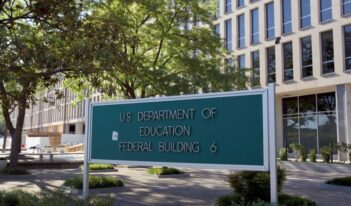
Regulatory efforts to help students identify cost-effective education programs meet mixed responses.
For many Americans, higher education promises upward social mobility. But growing concern over student debt has cast doubt on that narrative. Students who hope to advance their careers and increase their incomes by investing in education often struggle to repay their debt.
According to the U.S. Department of Education, college graduates’ incomes have not risen proportionately to tuition prices and borrowing levels. Furthermore, some institutions use deceptive tactics to recruit students for programs with poor employment outcomes.
To address this growing problem, the Education Department published a final rule this week aimed at ensuring that postsecondary education programs, such as college and vocational training, are worth the cost to students. Through the rule, the Education Department seeks to shift student enrollment toward programs with higher financial value—offering students higher earning potential for lower debt cost—by increasing transparency and implementing more robust gainful employment requirements.
The rule includes a financial value transparency framework, which evaluates programs on their students’ debt-to-income ratio and an earnings premium measure. The debt-to-income ratio compares students’ annual loan payments to their annual earnings. The earnings premium measure compares the earnings of program graduates to that of students with only a high school diploma or General Education Development certification. If a program’s median graduates have loan payments that are too high compared to their income, or if they make less than students without postsecondary education, the program fails to meet the financial value benchmarks.
Beginning in 2026, the Education Department will maintain a website that discloses programs’ financial value measures and other information. Programs that receive federal funding—including nearly all undergraduate, graduate, and vocational programs—will need to distribute this information to prospective students. Students who wish to enroll in certain failing programs will need to acknowledge that the financial value measures of the program fall below acceptable levels. Undergraduate degree programs, however, are exempt from the acknowledgement requirement.
For-profit and non-degree programs that “prepare students for gainful employment in a recognized occupation,” such as cosmetology and massage therapy programs, typically qualify for federal student aid initiatives. Under the rule’s gainful employment eligibility framework, however, programs that fail on either of the financial value measures in two of three consecutive years will no longer qualify as gainful employment programs. As a result, they will lose eligibility for federal funding, such as subsidized loans and Pell Grants.
Through these funding restrictions, the Education Department intends to protect taxpayers, as well as students. Programs that lead to poor student outcomes cost taxpayers disproportionately because student borrowers with low earnings are not required to pay back their federal loans in full. According to Education Department estimates, screening out low-performing programs and directing students toward higher-value programs may save taxpayers billions by increasing student loan-repayment rates, resulting in overall budget reductions.
Helping students seek out worthwhile educational opportunities may seem uncontroversial, but education experts and other stakeholders have long debated how best to achieve this goal. Over 7,500 parties commented on the Education Department’s proposed rule during its notice-and-comment period, and the agency dedicated nearly 90 pages of the final rule’s preamble to addressing these comments. While proponents applaud the rule for protecting students from investing in lower-value educational programs, critics condemn the rule for ignoring non-monetary benefits of education.
In this week’s Saturday Seminar, experts debate the merits of the Education Department’s final rule and propose solutions for improving higher education outcomes.
- Due to legal challenges and administration changes, the gainful employment rule has languished in regulatory uncertainty for nearly 15 years, explains Madison Weiss in a recent Center of American Progress article. Weiss, a policy analyst at the Center, traces the rule’s path from Congress’s first mention of “gainful employment” in the Higher Education Act of 1965 to the Obama Administration’s first gainful employment rule in 2011—and the numerous lawsuits that followed. Weiss argues that delayed implementation has allowed predatory programs to continue reaping federal funds while their graduates struggle to make a living wage. She contends that enforcing the rule will protect students and taxpayers from wasting resources on low-quality programs.
- Amber Villalobos and several coauthors at The Century Foundation commented in support of the Education Department’s notice of proposed rulemaking on gainful employment and related initiatives. Villalobos and her coauthors contend that strengthening gainful employment requirements will protect students from investing in low-value programs. In addition, the Villalobos team argues that the proposed rule’s debt-to-income test will ensure that students in career development programs graduate with manageable debt levels. The Villalobos team also provides recommendations to strengthen the rule. For example, they suggest that gainful employment disclosures should include information about a school’s spending on student instruction because higher proportions of instructional spending correlate with greater student success.
- In an article published by the IZA Institute of Labor Economics, Michael Lovenheim of Cornell University and Jonathan Smith of Georgia State University examine the return on student investment across different courses of study and types of institutions, such as four-year colleges and vocational schools. Lovenheim and Smith find that economically disadvantaged students are more likely than their peers to attend institutions that yield lower returns. Lovenheim and Smith cite for-profit schools as an example of low-return institutions that enroll a disproportionate number of low-income students. Because the enrollment disparity is driven in part by a lack of information, Lovenheim and Smith suggest simplifying application processes and offering low-income students supplemental admissions and financial aid guidance.
- In a comment on the proposed gainful employment rule, Adam Kissel and Lindsey Burke of the Heritage Foundation argue that regulating for-profit and non-profit postsecondary institutions differently violates administrative law’s reasonableness standard. Kissel and Burke contend that the rule ignores important dynamics in student earnings in ways that unfairly disadvantage for-profit postsecondary institutions. They also claim that the rule substitutes regulators’ risk tolerance for that of students and deprives historically disadvantaged students of opportunities to access higher education. Kissel and Burke anticipate expensive lawsuits challenging the rule’s reasonableness and point out that the Education Department ignored litigation costs when conducting its cost-benefit analysis.
- In an article published by the Brookings Institution, Dominique Baker of Southern Methodist University and several coauthors argue that information alone is insufficient to deter students from choosing low-performing schools. Baker and her coauthors observe that college is an “experience good,” so students may not know how well an institution will meet their needs until after attending. Baker and her coauthors cite research showing that government-mandated information disclosure alone does not elicit behavior changes in students or institutions. The Baker team concludes that although the government need not tell students which colleges to attend, it must “identify, sanction, and possibly close” colleges with poor outcomes that leave students financially worse off .
- In a comment responding to the Education Department’s proposed rule, the National Association of Student Financial Aid Administrators (NASFAA) argues that the value of higher education cannot be expressed solely in terms of graduate earnings. NASFAA contends that the gainful employment rule disadvantages postsecondary programs that emphasize intellectual growth rather than workforce training. NASFAA cautions that the rule could force closure of quality programs that fail to meet metrics but still have real value to students. NASFAA urges the Education Department to allow a broader range of factors to affect the its value metrics so that students can understand the whole value of postsecondary programs.
The Saturday Seminar is a weekly feature that aims to put into written form the kind of content that would be conveyed in a live seminar involving regulatory experts. Each week, The Regulatory Review publishes a brief overview of a selected regulatory topic and then distills recent research and scholarly writing on that topic.



